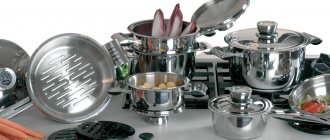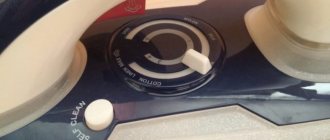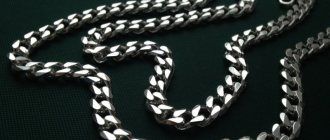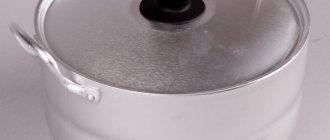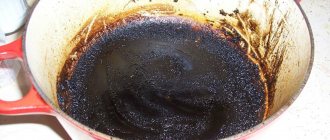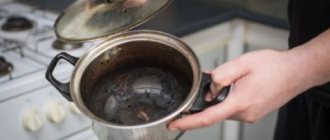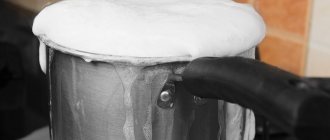/Order/
Sometimes dishes lose their beauty and shine as a result of long-term use, and sometimes it happens that cleaning is necessary due to our carelessness - when the pan is burnt and the bottom is covered with soot, which cannot be washed in the usual way.
- As a rule, before cleaning a burnt, old or simply very dirty pan, we soak it in a soapy solution and then try to wash it with brushes and hard sponges. Often this procedure solves the problem. But what to do in particularly difficult cases, when soaking does not help or when you just want to get through the routine as quickly as possible? From this article you will learn 8 tricks on how to clean pots as quickly as possible and with minimal effort using improvised and special means.
Before you get started, try to understand what material your pan is made of. After all, metals react differently to cleaning products. Thus, salt is harmful to stainless steel, acid is harmful to enamel, soda is harmful to aluminum, and any abrasives are harmful to all types of non-stick coatings. Read more about the rules for caring for pots depending on the type of material at the end of the article.
Method 1. First aid for a dirty/burnt pan - boiling with soapy water
To remove most mild to moderate dirt, this simple but effective method is often sufficient.
- Fill a pan with hot water and add a few drops of dishwashing liquid. Then place the utensils on the stove and bring the solution to a boil.
- Cook the soap solution over low heat for another 15 minutes or more (depending on the amount of soot).
- Use a spatula to scrape off any remaining residue from the pan. And wipe what remains on the walls and bottom with the hard side of the sponge.
Rating of popular chemicals
If folk remedies do not help, you can try using store-bought products. The following rating of the best chemicals will help you make your choice.
Amway. The Belgian-made product is a professional product. The composition has a thick consistency, so it easily penetrates deep into the dirt. Before use, be sure to wear gloves and open the window.
Before using the dishes, you need to rinse them several times under running water. The set comes with a brush along with the product. It needs to be generously lubricated with the composition, which is then applied to the surface of the dishes. Leave to act for half an hour (if heavily soiled, it can be for an hour). Rinse with clean water several times.
SanitaR. Suitable for cleaning pots and ovens, stoves and barbecues. The consistency is thick, so the product is consumed slowly. To remove carbon deposits, apply the gel in an even layer to the surface and leave to soften for 45–60 minutes. Then the softened carbon deposits are removed with a hard sponge or metal scraper (depending on the surface material).
Frosch. The product is produced for cleaning stoves and ovens, but it can also be used to clean pots. The main advantage of the product is its safety. At the same time, the product does not have an unpleasant odor. Consumption is also economical. The product is applied using a sprayer. Leave on the surface of the pan for 10–15 minutes. Remove carbon deposits with a sponge. Compared to the two previous options, this remedy is less effective, but it is safer.
"Schumannite" . A modern product that is suitable for cleaning many surfaces in the kitchen. Helps remove even stubborn stains. The composition has a pungent and pungent odor, so it is important to ventilate the room all the time when working with it. Gloves are also required. “Shumanite” is sprayed onto the surface and left for several minutes, then the dirt is removed with a damp sponge. If soot remains, repeat the procedure.
"Mr Muscle Expert" . To quickly clean the surface of the pan, it is recommended to choose a product marked “Expert”. It is more effective than conventional products of the same line and is inexpensive. It is necessary to spray the composition onto the dishes and leave for about 30 minutes. Softened dirt is removed with a soft sponge.
IMPORTANT! When choosing cleaning products, you need to pay attention to the marks on the packaging. It should indicate that the composition is intended specifically for removing carbon deposits. All-purpose cleaners will not remove heavy stains.
Method 2. How to clean a pan with soda and vinegar
This simple but working method is suitable for cleaning all types of pans (enamel, cast iron, Teflon and steel), but is NOT suitable for washing aluminum cookware without non-stick coating or enamel.
Instructions:
- Dilute water and 9% vinegar in a 1:1 ratio in a dirty saucepan so that the solution covers the dirt, then bring it to a boil.
- Remove the boiled solution from the heat (!) and add 2-3 tablespoons of soda to it - the mixture should foam and sizzle! Let it stand for another 10-20 minutes (you can put it back on low heat). As the burnt material softens, scrape it off with a spatula.
- Wash and rinse the pan as usual.
Adviсe:
- It is important to remove the pan from the heat as soon as the vinegar solution boils and only then add the soda. If this is not done, then you will have to wash the stove along with the dishes. At the same time, do not hesitate to add soda.
- Baking soda and vinegar work well separately.
- You can strengthen the soda-vinegar solution by adding a third of a bar of laundry soap (72%).
- Local dirt can be rubbed with a hard sponge and soda paste (soda + water in a 1:1 ratio).
- Stubborn deposits and grease on the outside and inside can be removed by boiling the pan for 30-120 minutes in a large container.
What you should absolutely not do or use
In order for your dishes to serve you long and faithfully, you need to know how to use them correctly:
- Enamel is a material that definitely should not be exposed to sudden temperature changes. Therefore, it is strictly forbidden to pour cold water into a hot pan and vice versa.
- Do not apply mechanical force to the dishes - careless handling can lead to chipping and destruction of the coating.
- Enameled kitchen utensils do not tolerate steel objects, which housewives often use in the cooking process, or washing with metal brushes and abrasives. For these purposes, it is better to give preference to products made of wood and plastic or soft sponges.
Method 3. How to clean burnt or very old pans
This Soviet trick with laundry soap and silicate glue is suitable for the most advanced cases, when the pan is covered with multi-layers of black soot and grease on the outside and inside.
You will need: For 4 liters of water you will need household supplies. soap 72% (1/3 or ½ bar), 1 cup silicate glue. Also prepare a medium grater and a large saucepan or metal bucket (for example, a 10-liter).
Instructions:
- Place the dirty pan in a larger bucket/pot, fill it with water and bring to a boil.
- While the water is heating, grate the laundry soap on a medium grater.
- Add soap shavings, silicate glue, and soda (optional) to boiled water.
- Boil the resulting mixture for 30 minutes or more depending on the degree of contamination, then wash the dishes as usual. Black burns and greasy deposits will come off easily.
Tip: to enhance the effect, you can add baking soda or soda ash to the solution at the rate of 1/3 pack per 4 liters of water (except for uncoated aluminum pans).
Removing stains from the sofa
Unpleasant odors, stains from coffee, fruits and juices - all this can be removed with a homemade product:
- To 0.5 liters of water add 150 ml of vinegar, 1 tbsp. l. soda and 100 ml of alcohol.
- Pour this mixture into a spray bottle and spray on the sofa.
- After 15 minutes, scrub the stain with a brush and then blot with a clean, damp cloth.
- Dry and vacuum the sofa.
Tip: Use baking soda separately for dry cleaning of furniture.
Method 4. How to clean a pan from fat and carbon deposits using salt
The best way to clean a cast iron pan or cauldron, as well as enamel utensils, is with salt. It absorbs fat perfectly. In addition, being a soft abrasive, it also removes burnt marks well.
- Place a few handfuls of salt in the bottom (the more fat, the more salt you need to use) and scrub with a paper towel and a couple drops of dishwashing liquid.
- Simply rinse the pan under water (you don't need to use dishwashing liquid).
Adviсe:
- It is better to clean a burnt cast iron pan with coarse salt.
- Any pan, except a steel one, can be easily cleaned of scale and carbon deposits by boiling a strong brine solution in it (5-6 tablespoons of salt per 1 liter of water) for 30-40 minutes over low heat.
Why does dirt appear on the pan?
As a result of operation, drops of fat and oil fall on the front side of the pan. This occurs when frying food on adjacent burners, boiling away liquid from dishes, moving food from one container to another, or when washing. During the heating process, these fat droplets undergo chemical changes with the formation of volatile and non-volatile degradation products. Most are non-volatile. They are represented by polymers of triglycerides. They increase the viscosity of the oil, resemble resin, and can burn. Their ability to be dissolved by detergents is lower than that of original fats. If not removed in a timely manner, they freeze and accumulate.
Beautiful and high-quality pots in the kitchen are the dream of housewives and the key to delicious dishes.
Method 5. How to clean a burnt pan with vinegar
Vinegar is a powerful anti-burn and anti-limescale agent. However, it is not advisable to use it for cleaning enamel pans.
Instructions:
- Fill the bottom of the pan with vinegar (9%) and let sit for 1-3 hours. As the burnt material softens, carefully scrape it off with a spatula. You can reduce the smell of vinegar by packing the pan in a bag or wrapping it in cling film. And, of course, don't forget to open the window!
- Wash the dishes as usual.
We fight blockages
Hair and food debris clog your kitchen and bathroom pipes. Special products solve this problem, but at the same time cause allergies and spread a toxic odor that causes coughing and watery eyes. So use vinegar and baking soda. The method is notable for the fact that the cleaning agent is prepared directly in the pipe.
Instructions:
- Pour half a cup of baking soda and the same amount of vinegar down the drain.
- Close the hole with a stopper and do not use the sink for several hours.
- When the allotted time has expired, remove the plug and pour water heated to 90 degrees into the pipe.
Important: Strictly follow the proportions; vinegar and soda should be used in equal parts.
Method 6. Cleaning with citric acid
If you don’t have vinegar at home, clean a burnt pan or dishes with limescale using citric acid. Like vinegar, citric acid is contraindicated for enamel cookware.
Instructions:
- To clean the pan, boil water in it (you don’t need a lot, the main thing is that the water covers the smoke), add 2 tbsp. spoons of citric acid and boil the resulting solution for another 15 minutes.
- As the burnt material softens, scrape it off with a spatula. Finally, wash the burnt bottom as usual.
What dishes should not be boiled to clean?
Not all dishes can be boiled. Cannot tolerate boiling:
- Aluminum cookware. Under the influence of high temperatures and aggressive chemicals it acquires a dark color.
- Glassware. Boiling is not recommended for several reasons. If the product has microcracks, it may burst. If the dishes are intact and subjected to boiling, an indelible coating remains on the walls, which spoils the appearance.
- Ceramic tableware. When boiling, the coating (glaze) is destroyed, which leads to loss of appearance.
- Plastic dishes. Boiling will simply melt the product, and further use will be impossible.
Note! It is recommended to clean glass, ceramic and plastic dishes with traditional or gentle chemicals to prevent loss of appearance or deformation.
Method 7. How to clean a pan from soot and grease using grease removers
Special grease removers come to the rescue in the most hopeless cases, when you need to wash very old and burnt pans with minimal effort. It is important to carry out cleaning with rubber gloves and with the windows open, and then thoroughly rinse off any remaining product. Keep in mind that most grease removers are contraindicated for washing aluminum and Teflon pans.
- Here are some super-effective products: Shumanit (Bagi), Oven Cleaner (Amway), Chister, Sparkling Kazan, Giant (Bagi).
General instructions:
- Treat problem areas with the product inside or outside the pan.
- Pack the pan in a bag or wrap it in cling film (!) - this trick will reduce the spread of the pungent odor throughout the apartment. Let the product work for 10-40 minutes.
- Wash the dishes as usual, then rinse them thoroughly several times.
Advice:
- To be on the safe side, chemical residues inside the pan can be removed with table vinegar (9%).
- If you have children or pets, it is better to use Amway Oven Cleaner. It is sold only through the company’s online store and dealers, it is quite expensive, but it works more efficiently and faster than its analogues, it is used economically, and most importantly, it has almost no smell.
Method 8. How to clean a pan with “White” or other chlorine bleach
Ordinary “Belizna” or any other equivalent cleans pots perfectly.
Instructions:
- Fill a pan with water and add Whiteness to it at the rate of 1 tablespoon/3 liters of water (approximately).
- Bring the resulting solution to a boil and cook for another 15-30 minutes.
- After boiling, wash the pan in the usual way, and then boil the dishes with clean water again to completely remove any remaining bleach.
- To be sure, you can wipe the inside of the pan with a vinegar solution.
Contraindications and recommendations for washing different types of pots
If you are viewing the table on a smartphone, turn it to a horizontal position so that the entire table fits into the screen.
| Stainless steel pan | Enameled utensils | Cast iron pan/cauldron | Aluminum cookware WITHOUT non-stick coating | Teflon pan (cookware with any non-stick coating) | |
| Contraindications | Does not tolerate the use of salt (the pan may darken and lose its shine) | Acids and harsh abrasives are contraindicated. | Do not soak for a long time, otherwise the dishes may become rusty. For the same reason, cast iron cauldrons and pans cannot be washed in the dishwasher. | Do not use soda to clean aluminum cookware or use alkali-based products - this can be harmful to both the utensils and humans. It is not advisable to wash an aluminum pan in the dishwasher. | Abrasive agents (including soda), hard brushes and sponges, and even more so scrapers are unacceptable. |
| Recommendations | You can restore the shine of a stainless steel pan with special cleaners for stainless steel utensils. | It’s good to use vinegar or salt - they can remove dark deposits or burnt marks inside the dishes | Soot, grease and rust from a cast iron pan can be easily removed with salt | It is good to use products based on ammonia, special products for cleaning porcelain or glassware | Manufacturers recommend cleaning pans with a non-stick coating by boiling a soap solution for 20 minutes. |
Support the project - share the material with your friends on social networks:
Cleaning features depending on the material of kitchen utensils
Not all special and home remedies are suitable for absolutely every pan . Some coatings have increased susceptibility, for example, to acids. If you use the wrong cleaning technique, you can damage the coating material and ruin the pan.
Stainless steel
Stainless steel cookware is shiny and stylish, and also very practical. This pan lasts a long time.
When cleaning from carbon deposits, it is possible to use various recipes, since stainless steel does not react with cleaning agents.
Allowed recipes containing:
- acids,
- soda,
- mustard, etc.
Non-stick
Special non-stick coatings are very sensitive to treatment with abrasives and chemicals.
You can tidy up the damaged pan in this way:
- Pre-soak with warm water.
- Use the recipe with mustard powder for scrubbing.
Soaking is the main action that allows you to remove carbon deposits without the risk of damaging the top layer.
Aluminum coating
Aluminum is a soft material that is destroyed upon contact with chlorine-containing products. To remove soot, acid-containing products are suitable, for example, recipes with citric acid, as well as long-term soaking of the soot layer. Due to the specifics of the material, aluminum cannot be rubbed with brushes with abrasive surfaces .
Enamel
When carbon deposits form, the enamel coating must first be soaked. It is not advisable to use compounds with acids for cleaning, as they can destroy the coating. A good choice is recipes based on mustard powder or soda.

